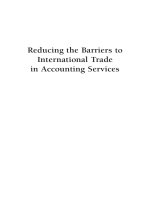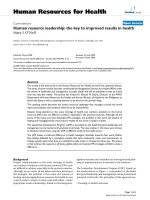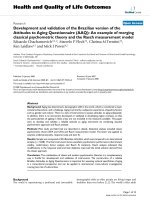The Microguide to Process Modeling in Bpmn 2.0 by MR Tom Debevoise and Rick Geneva_1 doc
Bạn đang xem bản rút gọn của tài liệu. Xem và tải ngay bản đầy đủ của tài liệu tại đây (1.98 MB, 27 trang )
4.Process Modeling
The goal for this chapter is to present the background and specific analysis techniques
needed to construct a statistical model that describes a particular scientific or
engineering process. The types of models discussed in this chapter are limited to those
based on an explicit mathematical function. These types of models can be used for
prediction of process outputs, for calibration, or for process optimization.
1. Introduction
Definition1.
Terminology2.
Uses3.
Methods4.
2. Assumptions
Assumptions1.
3. Design
Definition1.
Importance2.
Design Principles3.
Optimal Designs4.
Assessment5.
4. Analysis
Modeling Steps1.
Model Selection2.
Model Fitting3.
Model Validation4.
Model Improvement5.
5. Interpretation & Use
Prediction1.
Calibration2.
Optimization3.
6. Case Studies
Load Cell Output1.
Alaska Pipeline2.
Ultrasonic Reference Block3.
Thermal Expansion of Copper4.
Detailed Table of Contents: Process Modeling
References: Process Modeling
Appendix: Some Useful Functions for Process Modeling
4. Process Modeling
(1 of 2) [5/1/2006 10:21:49 AM]
4. Process Modeling
(2 of 2) [5/1/2006 10:21:49 AM]
4. Process Modeling - Detailed Table of
Contents [4.]
The goal for this chapter is to present the background and specific analysis techniques needed to
construct a statistical model that describes a particular scientific or engineering process. The types
of models discussed in this chapter are limited to those based on an explicit mathematical
function. These types of models can be used for prediction of process outputs, for calibration, or
for process optimization.
Introduction to Process Modeling [4.1.]
What is process modeling? [4.1.1.]1.
What terminology do statisticians use to describe process models? [4.1.2.]2.
What are process models used for? [4.1.3.]
Estimation [4.1.3.1.]1.
Prediction [4.1.3.2.]2.
Calibration [4.1.3.3.]3.
Optimization [4.1.3.4.]4.
3.
What are some of the different statistical methods for model building? [4.1.4.]
Linear Least Squares Regression [4.1.4.1.]1.
Nonlinear Least Squares Regression [4.1.4.2.]2.
Weighted Least Squares Regression [4.1.4.3.]3.
LOESS (aka LOWESS) [4.1.4.4.]4.
4.
1.
Underlying Assumptions for Process Modeling [4.2.]
What are the typical underlying assumptions in process modeling? [4.2.1.]
The process is a statistical process. [4.2.1.1.]1.
The means of the random errors are zero. [4.2.1.2.]2.
The random errors have a constant standard deviation. [4.2.1.3.]3.
The random errors follow a normal distribution. [4.2.1.4.]4.
The data are randomly sampled from the process. [4.2.1.5.]5.
1.
2.
4. Process Modeling
(1 of 5) [5/1/2006 10:21:37 AM]
The explanatory variables are observed without error. [4.2.1.6.]6.
Data Collection for Process Modeling [4.3.]
What is design of experiments (aka DEX or DOE)? [4.3.1.]1.
Why is experimental design important for process modeling? [4.3.2.]2.
What are some general design principles for process modeling? [4.3.3.]3.
I've heard some people refer to "optimal" designs, shouldn't I use those? [4.3.4.]4.
How can I tell if a particular experimental design is good for my
application? [4.3.5.]
5.
3.
Data Analysis for Process Modeling [4.4.]
What are the basic steps for developing an effective process model? [4.4.1.]1.
How do I select a function to describe my process? [4.4.2.]
Incorporating Scientific Knowledge into Function Selection [4.4.2.1.]1.
Using the Data to Select an Appropriate Function [4.4.2.2.]2.
Using Methods that Do Not Require Function Specification [4.4.2.3.]3.
2.
How are estimates of the unknown parameters obtained? [4.4.3.]
Least Squares [4.4.3.1.]1.
Weighted Least Squares [4.4.3.2.]2.
3.
How can I tell if a model fits my data? [4.4.4.]
How can I assess the sufficiency of the functional part of the model? [4.4.4.1.]1.
How can I detect non-constant variation across the data? [4.4.4.2.]2.
How can I tell if there was drift in the measurement process? [4.4.4.3.]3.
How can I assess whether the random errors are independent from one to the
next? [4.4.4.4.]
4.
How can I test whether or not the random errors are distributed
normally? [4.4.4.5.]
5.
How can I test whether any significant terms are missing or misspecified in the
functional part of the model? [4.4.4.6.]
6.
How can I test whether all of the terms in the functional part of the model are
necessary? [4.4.4.7.]
7.
4.
If my current model does not fit the data well, how can I improve it? [4.4.5.]
Updating the Function Based on Residual Plots [4.4.5.1.]1.
Accounting for Non-Constant Variation Across the Data [4.4.5.2.]2.
Accounting for Errors with a Non-Normal Distribution [4.4.5.3.]3.
5.
4.
4. Process Modeling
(2 of 5) [5/1/2006 10:21:37 AM]
Use and Interpretation of Process Models [4.5.]
What types of predictions can I make using the model? [4.5.1.]
How do I estimate the average response for a particular set of predictor
variable values? [4.5.1.1.]
1.
How can I predict the value and and estimate the uncertainty of a single
response? [4.5.1.2.]
2.
1.
How can I use my process model for calibration? [4.5.2.]
Single-Use Calibration Intervals [4.5.2.1.]1.
2.
How can I optimize my process using the process model? [4.5.3.]3.
5.
Case Studies in Process Modeling [4.6.]
Load Cell Calibration [4.6.1.]
Background & Data [4.6.1.1.]1.
Selection of Initial Model [4.6.1.2.]2.
Model Fitting - Initial Model [4.6.1.3.]3.
Graphical Residual Analysis - Initial Model [4.6.1.4.]4.
Interpretation of Numerical Output - Initial Model [4.6.1.5.]5.
Model Refinement [4.6.1.6.]6.
Model Fitting - Model #2 [4.6.1.7.]7.
Graphical Residual Analysis - Model #2 [4.6.1.8.]8.
Interpretation of Numerical Output - Model #2 [4.6.1.9.]9.
Use of the Model for Calibration [4.6.1.10.]10.
Work This Example Yourself [4.6.1.11.]11.
1.
Alaska Pipeline [4.6.2.]
Background and Data [4.6.2.1.]1.
Check for Batch Effect [4.6.2.2.]2.
Initial Linear Fit [4.6.2.3.]3.
Transformations to Improve Fit and Equalize Variances [4.6.2.4.]4.
Weighting to Improve Fit [4.6.2.5.]5.
Compare the Fits [4.6.2.6.]6.
Work This Example Yourself [4.6.2.7.]7.
2.
Ultrasonic Reference Block Study [4.6.3.]
Background and Data [4.6.3.1.]1.
3.
6.
4. Process Modeling
(3 of 5) [5/1/2006 10:21:37 AM]
Initial Non-Linear Fit [4.6.3.2.]2.
Transformations to Improve Fit [4.6.3.3.]3.
Weighting to Improve Fit [4.6.3.4.]4.
Compare the Fits [4.6.3.5.]5.
Work This Example Yourself [4.6.3.6.]6.
Thermal Expansion of Copper Case Study [4.6.4.]
Background and Data [4.6.4.1.]1.
Rational Function Models [4.6.4.2.]2.
Initial Plot of Data [4.6.4.3.]3.
Quadratic/Quadratic Rational Function Model [4.6.4.4.]4.
Cubic/Cubic Rational Function Model [4.6.4.5.]5.
Work This Example Yourself [4.6.4.6.]6.
4.
References For Chapter 4: Process Modeling [4.7.]7.
Some Useful Functions for Process Modeling [4.8.]
Univariate Functions [4.8.1.]
Polynomial Functions [4.8.1.1.]
Straight Line [4.8.1.1.1.]1.
Quadratic Polynomial [4.8.1.1.2.]2.
Cubic Polynomial [4.8.1.1.3.]3.
1.
Rational Functions [4.8.1.2.]
Constant / Linear Rational Function [4.8.1.2.1.]1.
Linear / Linear Rational Function [4.8.1.2.2.]2.
Linear / Quadratic Rational Function [4.8.1.2.3.]3.
Quadratic / Linear Rational Function [4.8.1.2.4.]4.
Quadratic / Quadratic Rational Function [4.8.1.2.5.]5.
Cubic / Linear Rational Function [4.8.1.2.6.]6.
Cubic / Quadratic Rational Function [4.8.1.2.7.]7.
Linear / Cubic Rational Function [4.8.1.2.8.]8.
Quadratic / Cubic Rational Function [4.8.1.2.9.]9.
Cubic / Cubic Rational Function [4.8.1.2.10.]10.
Determining m and n for Rational Function Models [4.8.1.2.11.]11.
2.
1.
8.
4. Process Modeling
(4 of 5) [5/1/2006 10:21:37 AM]
4. Process Modeling
(5 of 5) [5/1/2006 10:21:37 AM]
4. Process Modeling
4.1.Introduction to Process Modeling
Overview of
Section 4.1
The goal for this section is to give the big picture of function-based
process modeling. This includes a discussion of what process modeling
is, the goals of process modeling, and a comparison of the different
statistical methods used for model building. Detailed information on
how to collect data, construct appropriate models, interpret output, and
use process models is covered in the following sections. The final
section of the chapter contains case studies that illustrate the general
information presented in the first five sections using data from a variety
of scientific and engineering applications.
Contents of
Section 4.1
What is process modeling?1.
What terminology do statisticians use to describe process models?2.
What are process models used for?
Estimation1.
Prediction2.
Calibration3.
Optimization4.
3.
What are some of the statistical methods for model building?
Linear Least Squares Regression1.
Nonlinear Least Squares Regression2.
Weighted Least Squares Regression3.
LOESS (aka LOWESS)4.
4.
4.1. Introduction to Process Modeling
[5/1/2006 10:21:49 AM]
4. Process Modeling
4.1. Introduction to Process Modeling
4.1.1.What is process modeling?
Basic
Definition
Process modeling is the concise description of the total variation in one quantity, , by
partitioning it into
a deterministic component given by a mathematical function of one or more other
quantities,
, plus
1.
a random component that follows a particular probability distribution.2.
Example For example, the total variation of the measured pressure of a fixed amount of a gas in a tank can
be described by partitioning the variability into its deterministic part, which is a function of the
temperature of the gas, plus some left-over random error. Charles' Law states that the pressure of
a gas is proportional to its temperature under the conditions described here, and in this case most
of the variation will be deterministic. However, due to measurement error in the pressure gauge,
the relationship will not be purely deterministic. The random errors cannot be characterized
individually, but will follow some probability distribution that will describe the relative
frequencies of occurrence of different-sized errors.
Graphical
Interpretation
Using the example above, the definition of process modeling can be graphically depicted like
this:
4.1.1. What is process modeling?
(1 of 4) [5/1/2006 10:21:50 AM]
Click Figure
for Full-Sized
Copy
The top left plot in the figure shows pressure data that vary deterministically with temperature
except for a small amount of random error. The relationship between pressure and temperature is
a straight line, but not a perfect straight line. The top row plots on the right-hand side of the
equals sign show a partitioning of the data into a perfect straight line and the remaining
"unexplained" random variation in the data (note the different vertical scales of these plots). The
plots in the middle row of the figure show the deterministic structure in the data again and a
histogram of the random variation. The histogram shows the relative frequencies of observing
different-sized random errors. The bottom row of the figure shows how the relative frequencies of
the random errors can be summarized by a (normal) probability distribution.
An Example
from a More
Complex
Process
Of course, the straight-line example is one of the simplest functions used for process modeling.
Another example is shown below. The concept is identical to the straight-line example, but the
structure in the data is more complex. The variation in
is partitioned into a deterministic part,
which is a function of another variable,
, plus some left-over random variation. (Again note the
difference in the vertical axis scales of the two plots in the top right of the figure.) A probability
distribution describes the leftover random variation.
4.1.1. What is process modeling?
(2 of 4) [5/1/2006 10:21:50 AM]
An Example
with Multiple
Explanatory
Variables
The examples of process modeling shown above have only one explanatory variable but the
concept easily extends to cases with more than one explanatory variable. The three-dimensional
perspective plots below show an example with two explanatory variables. Examples with three or
more explanatory variables are exactly analogous, but are difficult to show graphically.
4.1.1. What is process modeling?
(3 of 4) [5/1/2006 10:21:50 AM]
4.1.1. What is process modeling?
(4 of 4) [5/1/2006 10:21:50 AM]
4. Process Modeling
4.1. Introduction to Process Modeling
4.1.2.What terminology do statisticians use
to describe process models?
Model
Components
There are three main parts to every process model. These are
the response variable, usually denoted by
,1.
the mathematical function, usually denoted as
, and2.
the random errors, usually denoted by
.3.
Form of
Model
The general form of the model is
.
All process models discussed in this chapter have this general form. As
alluded to earlier, the random errors that are included in the model make
the relationship between the response variable and the predictor
variables a "statistical" one, rather than a perfect deterministic one. This
is because the functional relationship between the response and
predictors holds only on average, not for each data point.
Some of the details about the different parts of the model are discussed
below, along with alternate terminology for the different components of
the model.
Response
Variable
The response variable,
, is a quantity that varies in a way that we hope
to be able to summarize and exploit via the modeling process. Generally
it is known that the variation of the response variable is systematically
related to the values of one or more other variables before the modeling
process is begun, although testing the existence and nature of this
dependence is part of the modeling process itself.
4.1.2. What terminology do statisticians use to describe process models?
(1 of 3) [5/1/2006 10:21:51 AM]
Mathematical
Function
The mathematical function consists of two parts. These parts are the
predictor variables,
, and the parameters, . The
predictor variables are observed along with the response variable. They
are the quantities described on the previous page as inputs to the
mathematical function,
. The collection of all of the predictor
variables is denoted by
for short.
The parameters are the quantities that will be estimated during the
modeling process. Their true values are unknown and unknowable,
except in simulation experiments. As for the predictor variables, the
collection of all of the parameters is denoted by
for short.
The parameters and predictor variables are combined in different forms
to give the function used to describe the deterministic variation in the
response variable. For a straight line with an unknown intercept and
slope, for example, there are two parameters and one predictor variable
.
For a straight line with a known slope of one, but an unknown intercept,
there would only be one parameter
.
For a quadratic surface with two predictor variables, there are six
parameters for the full model.
.
4.1.2. What terminology do statisticians use to describe process models?
(2 of 3) [5/1/2006 10:21:51 AM]
Random
Error
Like the parameters in the mathematical function, the random errors are
unknown. They are simply the difference between the data and the
mathematical function. They are assumed to follow a particular
probability distribution, however, which is used to describe their
aggregate behavior. The probability distribution that describes the errors
has a mean of zero and an unknown standard deviation, denoted by
,
that is another parameter in the model, like the
's.
Alternate
Terminology
Unfortunately, there are no completely standardardized names for the
parts of the model discussed above. Other publications or software may
use different terminology. For example, another common name for the
response variable is "dependent variable". The response variable is also
simply called "the response" for short. Other names for the predictor
variables include "explanatory variables", "independent variables",
"predictors" and "regressors". The mathematical function used to
describe the deterministic variation in the response variable is sometimes
called the "regression function", the "regression equation", the
"smoothing function", or the "smooth".
Scope of
"Model"
In its correct usage, the term "model" refers to the equation above and
also includes the underlying assumptions made about the probability
distribution used to describe the variation of the random errors. Often,
however, people will also use the term "model" when referring
specifically to the mathematical function describing the deterministic
variation in the data. Since the function is part of the model, the more
limited usage is not wrong, but it is important to remember that the term
"model" might refer to more than just the mathematical function.
4.1.2. What terminology do statisticians use to describe process models?
(3 of 3) [5/1/2006 10:21:51 AM]
4. Process Modeling
4.1. Introduction to Process Modeling
4.1.3.What are process models used for?
Three Main
Purposes
Process models are used for four main purposes:
estimation,1.
prediction,2.
calibration, and3.
optimization.4.
The rest of this page lists brief explanations of the different uses of
process models. More detailed explanations of the uses for process
models are given in the subsections of this section listed at the bottom
of this page.
Estimation
The goal of estimation is to determine the value of the regression
function (i.e., the average value of the response variable), for a
particular combination of the values of the predictor variables.
Regression function values can be estimated for any combination of
predictor variable values, including values for which no data have been
measured or observed. Function values estimated for points within the
observed space of predictor variable values are sometimes called
interpolations. Estimation of regression function values for points
outside the observed space of predictor variable values, called
extrapolations, are sometimes necessary, but require caution.
Prediction The goal of prediction is to determine either
the value of a new observation of the response variable, or1.
the values of a specified proportion of all future observations of
the response variable
2.
for a particular combination of the values of the predictor variables.
Predictions can be made for any combination of predictor variable
values, including values for which no data have been measured or
observed. As in the case of estimation, predictions made outside the
observed space of predictor variable values are sometimes necessary,
but require caution.
4.1.3. What are process models used for?
(1 of 2) [5/1/2006 10:21:51 AM]
Calibration The goal of calibration is to quantitatively relate measurements made
using one measurement system to those of another measurement system.
This is done so that measurements can be compared in common units or
to tie results from a relative measurement method to absolute units.
Optimization Optimization is performed to determine the values of process inputs that
should be used to obtain the desired process output. Typical
optimization goals might be to maximize the yield of a process, to
minimize the processing time required to fabricate a product, or to hit a
target product specification with minimum variation in order to
maintain specified tolerances.
Further
Details
Estimation1.
Prediction2.
Calibration3.
Optimization4.
4.1.3. What are process models used for?
(2 of 2) [5/1/2006 10:21:51 AM]
4. Process Modeling
4.1. Introduction to Process Modeling
4.1.3. What are process models used for?
4.1.3.1.Estimation
More on
Estimation
As mentioned on the preceding page, the primary goal of estimation is to determine the value of
the regression function that is associated with a specific combination of predictor variable values.
The estimated values are computed by plugging the value(s) of the predictor variable(s) into the
regression equation, after estimating the unknown parameters from the data. This process is
illustrated below using the Pressure/Temperature example from a few pages earlier.
Example Suppose in this case the predictor variable value of interest is a temperature of 47 degrees.
Computing the estimated value of the regression function using the equation
yields an estimated average pressure of 192.4655.
4.1.3.1. Estimation
(1 of 4) [5/1/2006 10:21:52 AM]
Of course, if the pressure/temperature experiment were repeated, the estimates of the parameters
of the regression function obtained from the data would differ slightly each time because of the
randomness in the data and the need to sample a limited amount of data. Different parameter
estimates would, in turn, yield different estimated values. The plot below illustrates the type of
slight variation that could occur in a repeated experiment.
Estimated
Value from
a Repeated
Experiment
4.1.3.1. Estimation
(2 of 4) [5/1/2006 10:21:52 AM]
Uncertainty
of the
Estimated
Value
A critical part of estimation is an assessment of how much an estimated value will fluctuate due
to the noise in the data. Without that information there is no basis for comparing an estimated
value to a target value or to another estimate. Any method used for estimation should include an
assessment of the uncertainty in the estimated value(s). Fortunately it is often the case that the
data used to fit the model to a process can also be used to compute the uncertainty of estimated
values obtained from the model. In the pressure/temperature example a confidence interval for the
value of the regresion function at 47 degrees can be computed from the data used to fit the model.
The plot below shows a 99% confidence interval produced using the original data. This interval
gives the range of plausible values for the average pressure for a temperature of 47 degrees based
on the parameter estimates and the noise in the data.
99%
Confidence
Interval for
Pressure at
T=47
4.1.3.1. Estimation
(3 of 4) [5/1/2006 10:21:52 AM]
Length of
Confidence
Intervals
Because the confidence interval is an interval for the value of the regression function, the
uncertainty only includes the noise that is inherent in the estimates of the regression parameters.
The uncertainty in the estimated value can be less than the uncertainty of a single measurement
from the process because the data used to estimate the unknown parameters is essentially
averaged (in a way that depends on the statistical method being used) to determine each
parameter estimate. This "averaging" of the data tends to cancel out errors inherent in each
individual observed data point. The noise in the this type of result is generally less than the noise
in the prediction of one or more future measurements, which must account for both the
uncertainty in the estimated parameters and the uncertainty of the new measurement.
More Info
For more information on the interpretation and computation confidence, intervals see Section 5.1
4.1.3.1. Estimation
(4 of 4) [5/1/2006 10:21:52 AM]
4. Process Modeling
4.1. Introduction to Process Modeling
4.1.3. What are process models used for?
4.1.3.2.Prediction
More on
Prediction
As mentioned earlier, the goal of prediction is to determine future value(s) of the response
variable that are associated with a specific combination of predictor variable values. As in
estimation, the predicted values are computed by plugging the value(s) of the predictor variable(s)
into the regression equation, after estimating the unknown parameters from the data. The
difference between estimation and prediction arises only in the computation of the uncertainties.
These differences are illustrated below using the Pressure/Temperature example in parallel with
the example illustrating estimation.
Example Suppose in this case the predictor variable value of interest is a temperature of 47 degrees.
Computing the predicted value using the equation
yields a predicted pressure of 192.4655.
4.1.3.2. Prediction
(1 of 5) [5/1/2006 10:21:52 AM]
Of course, if the pressure/temperature experiment were repeated, the estimates of the parameters
of the regression function obtained from the data would differ slightly each time because of the
randomness in the data and the need to sample a limited amount of data. Different parameter
estimates would, in turn, yield different predicted values. The plot below illustrates the type of
slight variation that could occur in a repeated experiment.
Predicted
Value from
a Repeated
Experiment
4.1.3.2. Prediction
(2 of 5) [5/1/2006 10:21:52 AM]
Prediction
Uncertainty
A critical part of prediction is an assessment of how much a predicted value will fluctuate due to
the noise in the data. Without that information there is no basis for comparing a predicted value to
a target value or to another prediction. As a result, any method used for prediction should include
an assessment of the uncertainty in the predicted value(s). Fortunately it is often the case that the
data used to fit the model to a process can also be used to compute the uncertainty of predictions
from the model. In the pressure/temperature example a prediction interval for the value of the
regresion function at 47 degrees can be computed from the data used to fit the model. The plot
below shows a 99% prediction interval produced using the original data. This interval gives the
range of plausible values for a single future pressure measurement observed at a temperature of
47 degrees based on the parameter estimates and the noise in the data.
99%
Prediction
Interval for
Pressure at
T=47
4.1.3.2. Prediction
(3 of 5) [5/1/2006 10:21:52 AM]
Length of
Prediction
Intervals
Because the prediction interval is an interval for the value of a single new measurement from the
process, the uncertainty includes the noise that is inherent in the estimates of the regression
parameters and the uncertainty of the new measurement. This means that the interval for a new
measurement will be wider than the confidence interval for the value of the regression function.
These intervals are called prediction intervals rather than confidence intervals because the latter
are for parameters, and a new measurement is a random variable, not a parameter.
Tolerance
Intervals
Like a prediction interval, a tolerance interval brackets the plausible values of new measurements
from the process being modeled. However, instead of bracketing the value of a single
measurement or a fixed number of measurements, a tolerance interval brackets a specified
percentage of all future measurements for a given set of predictor variable values. For example, to
monitor future pressure measurements at 47 degrees for extreme values, either low or high, a
tolerance interval that brackets 98% of all future measurements with high confidence could be
used. If a future value then fell outside of the interval, the system would then be checked to
ensure that everything was working correctly. A 99% tolerance interval that captures 98% of all
future pressure measurements at a temperature of 47 degrees is 192.4655 +/- 14.5810. This
interval is wider than the prediction interval for a single measurement because it is designed to
capture a larger proportion of all future measurements. The explanation of tolerance intervals is
potentially confusing because there are two percentages used in the description of the interval.
One, in this case 99%, describes how confident we are that the interval will capture the quantity
that we want it to capture. The other, 98%, describes what the target quantity is, which in this
case that is 98% of all future measurements at T=47 degrees.
4.1.3.2. Prediction
(4 of 5) [5/1/2006 10:21:52 AM]









